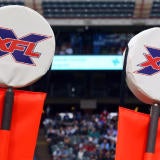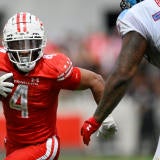XFL commissioner Oliver Luck understood it as well as anyone. "Quarterbacks are like Caesar," he said. "They're first among equals."
Simplistic as it is, the XFL has a puncher's chance to not just survive, but thrive, if -- and only if -- the football is watchable. For the football to be watchable, the offenses need to produce -- at least enough to match the defenses. For the offenses to produce, quarterback play needs to be good. So if you want to boil down the XFL's on-field strategy for long-term viability, it rests in the hands of the quarterbacks.
Duh, right? But here's the problem to which every XFL team is trying to find a solution: For quarterback play to be good, you need to do two things; incentivize the best available talent with more money (check) and create competition with other quality quarterbacks. The thing is, there aren't going to be 16 great quarterbacks (two per team) in the XFL, just as there aren't 32 great NFL quarterbacks.
This is where scouting comes into play. For now, at least, the XFL's goal is finding hidden gems -- guys who have a couple of pieces to work with, but perhaps not the whole package just yet. That's true for any position, but especially so at quarterback, a position of scarcity when it comes to quality.
Is the XFL here to stay? Brady Quinn joins Will Brinson to break down the new football league on the Pick Six Podcast. Listen below and be sure to subscribe for daily NFL goodness fired into your eardrums.
The conundrum is that the league is not going to sign big names like Colin Kaepernick because it can't afford him. It could sign a Johnny Manziel or Tim Tebow type based on the name, but there's no guarantee that's going to produce a better product than what the XFL already has behind center. Other than two games with the AAF last year, Manziel last played pro American football in 2015. Same with Tebow, minus the AAF stint.
The league could sign up-and-coming players early out of college, but at the rate the XFL is able to pay its players, they ones they're able to sign will need more work. In Week 1, however, a few under-the-radar names made huge impressions, including Houston's P.J. Walker, D.C.'s Cardale Jones and St. Louis' Jordan Ta'amu. All were forgotten in the NFL, but thrived in Week 1 victories. They each threw for more than 200 yards, had passer ratings of over 100 and combined for seven touchdowns to one interception. They also contributed heavily in the ground game, a common theme in what appears to be the dividing line among quarterbacks in this league.
Trey Brown, St. Louis' Director of Player Personnel, noted that having a dual-threat-type quarterback can give you a leg up in the XFL. "We did a lot of studying on the quarterback position, the entire staff did a great job of diving into that position. It's a position you always want to get right and get multiple QBs," Brown told CBS Sports. "One of the things we look for is the mobility and the skill set of extending the play. You can do that from a lot of different ways -- you can be a guy who can step up and pick up yards with your legs or you can be the guy that knows where the rush is coming from, knowing protection really well.
"During the week, it's easy for us to simulate 7-on-7, but how often do you simulate a true dual-threat?" Brown continued. "Most times in practice these guys are wearing red jerseys so you don't get to see traditional runs you see on game day. So their value rises on game day because you don't get to see those things in practice otherwise."
Fit is important, too, perhaps just as much as skill set. For Walker, who by NFL standards is a couple of inches too short and perhaps a tick too slow in the 40 to make up for it, June Jones' run-and-shoot offense with the Roughnecks was a perfect match. "We knew more about P.J. because of our past. June coached against P.J. when he was at Temple," said Randy Mueller, Houston's director of player personnel. "We know what he is. He's improved off that level. If he can put together a body of work that is sustainable, he has a chance to make an NFL roster."
Your FIRST EVER #XFL Star of the Week is @XFLRoughnecks QB PJ Walker.
— XFL (@xfl2020) February 12, 2020
Congrats, @pjwalker_5 ! pic.twitter.com/DL7Q6XyXjO
Granted, having a dual-threat player isn't necessary. Matt McGloin of the New York Guardians played well in a 23-3 rout over Tampa Bay. Conversely, it's not like you can put L.A's 37-17 loss to Houston on quarterback Chad Kanoff, a guy who caught Luck's eye even before the season began. "He was on [the Tampa Bay Buccaneers'] practice squad for the entire year and long story short, he signs with the Guardians, gets traded for Luis Perez at L.A. and then he plays a half of scrimmage and he looks awesome," Luck said.
But having a guy who can extend plays in any capacity is important while offensive lines, and pass protection in general, are developing. Mueller noted that it's becoming exceedingly difficult to scout offensive linemen because there simply aren't enough great ones going around. And with the rapid rise of dual-threat quarterbacks through all levels of football, offensive linemen aren't blocking the way they used to. Instead, scouts have to rely more on one or two skills that they can develop.
The result can be what Tampa Bay experienced with Aaron Murray (three turnovers) or what Dallas had with Philip Nelson (zero touchdowns). It's not that Nelson was incompetent -- he completed 79% of his passes, best among starting QBs in Week 1 -- but practically all of his passes were check downs. Some of that had to do with St. Louis' defensive game plan, as noted by BattleHawks coach Jonathan Hayes. "They like to run a lot of the mesh routes, the crossing routes, but they're going to take their shots when they get opportunities. We tried to limit those opportunities," Hayes said. But the reality is Nelson also wasn't able to push the ball down the field and few attempts were made on that front until the fourth quarter. Perhaps when Landry Jones is back and healthy from his knee injury, the Renegades will be able to open it up more.
Overall, the Week 1 product in the XFL was as good as, if not a little bit better, than Week 1 of the AAF a year ago. Some of that has to do with the time all eight teams spent together before the start of the year. That gave quarterbacks greater opportunities to develop chemistry with all facets of their offenses. "I'll credit June 100%," Mueller said. "He knows how to teach his system and the reps required. I'd be surprised if anyone worked harder with reps than we did in the past few months."
Ta'amu echoed that sentiment after Sunday's 15-9 victory over the Renegades. "I'd practice day-in and day-out with the receivers making sure I know I each individual and what they want," Ta'amu said. "They have different strengths. Some guys are lengthy, some guys are speed. Some like to cut, some guys like to round. Being able to work with them was really good."
Still, this is an obvious work-in-progress. XFL teams averaged 19.3 points per game in Week 1, not all of which were on offense. Not that the league has to hit a benchmark for points per game, but with the way the rules are geared to favor offenses, it should pick up as these players spend more time around one another.
"It's not Year 2, Year 3 of this league," Brown said. "These guys were competing for starting jobs. And now they are settling in as starters and getting reps. Now you have a core group of guys who can work together. Now as the season grows you're going to see all these quarterbacks and wide receivers get more comfortable working together."
Those reps take time, especially at quarterback. But if the scouting departments do their jobs well, there could be enough playmakers unearthed to make the XFL a viable, stand-alone football league. "There are so many great details to the quarterback position. These guys can sharpen their skills, from verbalizing the offense, speaking in the huddle, working the cadence ... those things where, if you're the third string quarterback or practice squad quarterback you don't have the opportunity to do that," Brown said. "So when you're in the XFL, you get those reps. They're learning to be better leaders and players overall, and sharpening their skills."
















